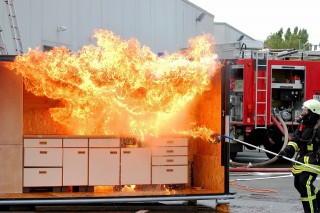
Contents
3D prints made from ULTEM™ (1010/9085) are in particularly high demand for aircraft interiors
A material that can show the fire protection standard UL94V0 must have held up well in the laboratory. In the test required for this internationally recognized certificate, the test object is immersed twice for 10 seconds each in a self-extinguishing Bunsen burner flame with a power of 50 watts (corresponding to a height of 20 mm), which may continue to climb for a maximum of 30 seconds. Only when the material has passed this test without catching fire or flaking into flaming drops can it be adorned with the UL94V0 standard.
Incidentally, this certified standard is issued by the US company Underwriters Laboratories (=UL), which was founded in 1894 with the aim of examining and certifying products and materials with regard to their safety, including with regard to fire protection. While UL’s headquarters are in Northbrook, Illinois, UL International Germany GmbH, based in Neu-Isenburg in southern Hesse, is responsible for both Europe and Latin America.
Aircraft and vehicle construction as classic fields of application for ULTEM™ (1010/9085)
3D printed components made of refractory materials are required (and therefore also 3D models made of ULTEM™, of course, wherever fire protection is a particularly important question of safety. This applies not least to aircraft interiors, but also to vehicle construction, because In the EU, aircraft and motor vehicle fittings must always be flame-retardant in order to increase the chances of the occupants surviving in the event of an accident.
3D printing with ULTEM™ (1010/9085) is based on FDM processes
ULTEM™ (1010/9085) is used as a 3D material, as is the widely used ABS (=acrylonitrile butadiene styrene) using the FDM (= fused deposition modelling) process. This 3D printing technology, also known as fusion layering, developed by the American Scott Crump in the late 1980s, is based on the fact that the starting material (ULTEM™ in this case) is a extruder fed in wire or rod form and melted there. The plastic melted in this way is then applied layer by layer to a (usually heated) printing bed based on the data in the CAD file.

While ULTEM™ 1010 meets NSF 51 food contact certification, ISO 10993 and USP Class VI biocompatibility standards (with heat resistance up to 153°C), ULTEM™ 9085 is heat resistant up to 231°C and this material meets FST safety standards .
If you would like to find out more about our diverse range of materials, you should visit our website. There you will also get to know our extensive range of services.
to materials


